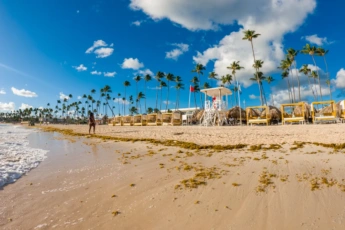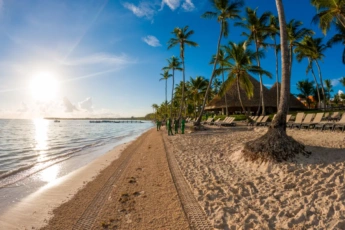Internet in the Dominican Republic – Cheapest Prices, Fastest Providers, and Best Options in 2025
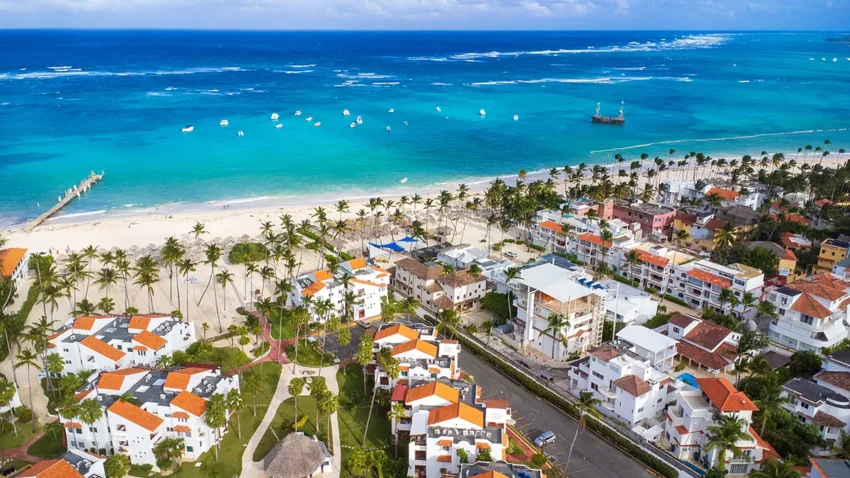
Punta Cana, Bavaro, Dominican Republic (December, 2023)
In today’s world, an internet connection is just as important as breathing. Whether you’re a tourist enjoying the Dominican Republic’s beautiful beaches or a remote worker, you might wonder, “How good is the internet in the DR?” And if you don’t have time to read, here’s the ultimate conclusion:
- You can expect good internet (mobile, fixed, and public WiFi) in big cities and popular tourist areas like Bavaro, Punta Cana, Cap Cana, Casa de Campo etc.
- You can buy a local SIM-card (Claro or Altice providers) for about $2.7 USD at a nearby supermarket without any problems. But keep in mind, that buying a local SIM card requires personal presence with a passport. A copy of your passport and a photo holding the SIM card are taken for registration.
- The prices for mobile internet vary depending on the operator, but in general they are about $3 USD for 5 days
- The average monthly price for fixed unlimited broadband internet in the Dominican Republic is $38.70 USD depending on download and upload speed.
- The median mobile internet connection speed via cellular networks is about 20.40 Mbps. The median fixed internet connection speed is about 19.28 Mbps at the beginning of 2025.
- If you’re planning to stay for a longer period, consider getting both a fixed broadband internet connection and mobile internet for more reliability.
- The biggest and the best internet providers are Claro and Altice.
- 5G network is here, but it’s just starting out.
Options to connect to the Internet
in the Dominican Republic
The country offers two primary internet access methods: mobile internet and fixed broadband connection.
1. Mobile internet
For the adventurer or the casual tourist, mobile internet offers the flexibility and connectivity you need:
- A local SIM card. Local prepaid SIM cards, particularly one from Claro or Altice with its 4G/5G network capabilities, can provide a steady internet connection. You can buy it for about $2.7 USD at a nearby local supermarket like Jumbo, Bluemall etc. Keep in mind that some Dominican Airports do not have SIM card stores.
- An e-SIM card is another excellent option for those who want to check their internet access before arriving. You can conveniently order it online before your trip, allowing for a seamless connection upon arrival. However, they are more expensive compared to local prepaid SIM cards.
Claro. This provider is recommended due to its better 4G/5G network coverage and fast mobile data speed. A Claro prepaid SIM card costs about $6 USD for 8 GB of data over 5 days.
Altice. You can consider it as an alternative provider. It also offers competitive plans, with options like unlimited data for 1 to 5 days ranging from $0.9 to $2.5 USD, and a tourist SIM card with 15 GB of data plus unlimited calls/SMS for $10.
Mobile providers offer various data packages at affordable rates, allowing you to use your phone as a hotspot to tether other devices, like your laptop, whenever needed. Another handy solution for those on the go is pocket Wi-Fi. It taps into the 4G LTE network and is provided by most major carriers, ensuring you can stay online even when you’re off the beaten path.
2. Fixed internet
If you are going to stay in the Dominican Republic for a long period, or you’re setting up a temporary workspace in a hotel, villa, or apartment, landline internet is often included. This fixed form of internet can be in the guise of DSL, cable, or the increasingly available fiber optic connections. Here’s what you need to know:
- The major ISPs in the DR include Claro, Altice, and Wind Telecom. These providers offer a range of internet services such as fiber optic, cable, and DSL connections.
- In 2025, the average monthly price for fixed broadband internet in the Dominican Republic is $38.70 USD. This places the Dominican Republic at the 89th position among countries surveyed for broadband internet prices.
- You’ll most likely have access to fixed internet in the cities or popular tourist spots like Punta Cana. It’s generally more stable and offers higher speeds, making it a solid choice for those needing a reliable connection for work or leisure.
- Fiber-optic internet is the gold standard for the most consistent and fastest connections. It’s perfect for remote workers who can’t afford to have their connection drop during a vital video conference or while sending a large file.
Remote workers should think about a dual approach. Combining a fast broadband landline connection with a mobile SIM card can save the day if one fails, mainly when unexpected situations occur, like construction work or service outages in your area.
How do you get a local SIM card
in the Dominican Republic?
Getting a SIM card for your mobile device in the Dominican Republic is hassle-free. Here’s a step-by-step guide to help you navigate the process:
- Bring valid identification. Head to a nearby mall where you’ll find Claro/Altice stores. Be sure to carry a valid identification document, such as your passport or driver’s license.
- The store employees will take a photo of you and your identification at the store for verification purposes. This step helps ensure the security of your connection.
- The store employees will associate your device’s IMEI number with the SIM card. This unique identification is essential for tracking and enhancing security.
- Signing an Agreement. Finally, you’ll be asked to sign an agreement. The store will compare your signature to the one on your ID to confirm your identity.
That’s all there is to it! The process is straightforward, ensuring you can quickly stay connected and enjoy uninterrupted access to your favorite content with your chosen service plan.
Purchasing a prepaid SIM card at Punta Cana Airport and Santiago de los Caballeros Airport is impossible. Therefore, arranging a connection at the nearest shopping center or store is better.
Dominican Republic internet speeds
Let’s look at the performance metrics of the top fixed broadband providers in the Dominican Republic for 2025 to help you identify the best download and upload speeds, latency, and consistency options.
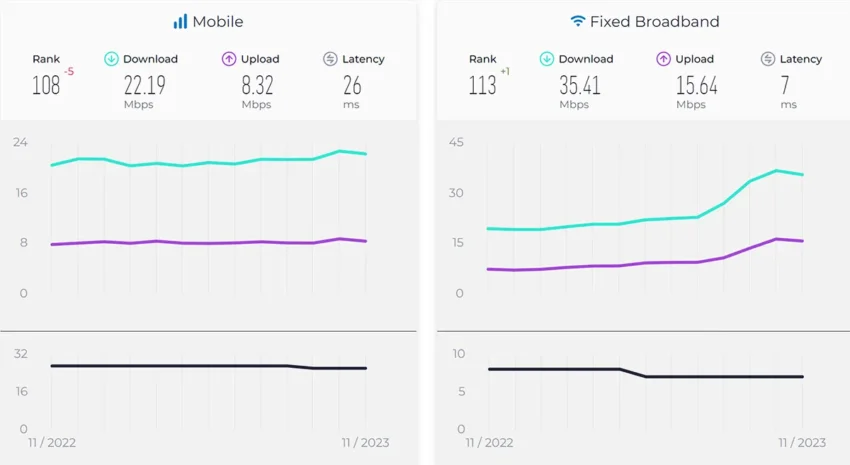
Dominican Republic Median Country Speeds
- Download Speeds. SpaceX Starlink led the pack with the fastest median download speed of 57.31 Mbps. Following SpaceX are Altice at 29.59 Mbps, Claro at 22.76 Mbps, and Wind Telecom at 14.03 Mbps.
- Upload Speeds. Regarding median upload speed, Altice topped the list at 9.91 Mbps. Claro followed closely with 9.67 Mbps, SpaceX Starlink at 8.79 Mbps, and Wind Telecom at 2.84 Mbps.
- Multi-Server Latency. The latency results did not show a statistical winner among the providers. The median latencies are 40 ms for Wind Telecom, 41 ms for Claro, 60 ms for Altice, and 109 ms for SpaceX Starlink.
- Consistency. In measuring the consistency of performance, SpaceX Starlink has the highest consistency rate, with 65% of results showing at least 25 Mbps minimum download speed and 3 Mbps minimum upload speed. The other providers follow with Altice at 53.7%, Claro at 46.3%, and WIND Telecom at 35.6%.
Dominican Republic Median Country Speeds in 2025
| Mobile | Fixed broadband | |
|---|---|---|
| Download | 22.19 Mbps | 35.41 Mbps |
| Upload | 8.32 Mbps | 15.64 Mbps |
| Latency | 26 ms | 7 ms |
Source: speedtest.net
Does the Dominican Republic have 5G?
5G technology is at an early development and deployment stage in the Dominican Republic. The country’s leading telecommunications companies are working to deploy 5G networks, but the technology has not yet been widely adopted.
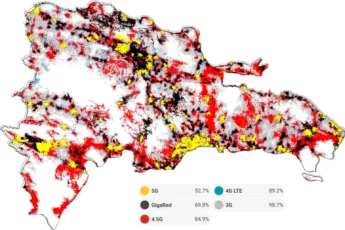
Map of 5G coverage (Claro) in the Dominican Republic for August 2023
The coverage is about 8% and may be affected at any time by various conditions external to the network, such as atmospheric conditions and terrain, interference, and other technical situations inherent in mobile networks. In comparison, 3G coverage is 98.8%, and 4G coverage is 97.6% of the Dominican Republic. Claro Dominicana and Altice, two leading telecom operators in the country, announced the launch of its 5G network in some areas on a trial basis.
What is the best internet provider
in the Dominican Republic?
When choosing your internet service provider in the Dominican Republic, the top names are Claro and Altice. In the Dominican Republic, these providers offer a range of options to cater to various preferences and needs, ensuring that you can find the right fit for your connectivity requirements.
According to Speedtest data for 2025, Claro stands out as the top mobile operator in the Dominican Republic, delivering the fastest median download speed among these leading providers at a remarkable 32.22 Mbps. Now, let’s delve into the mobile internet offerings of each provider.
Prepaid mobile Internet plans from Claro
- 1 hour: $0,26 USD
- 3 hours: $0,53 USD
- 6 hours: $0,70 USD
- 1 GB/1 day: $0,65 USD
- 3 GB/3 days: $1,67 USD
- 5 GB/5 days: $2,55 USD
- 10 GB/10 days: $5,19 USD
- 15 GB/15 days: $7,92 USD
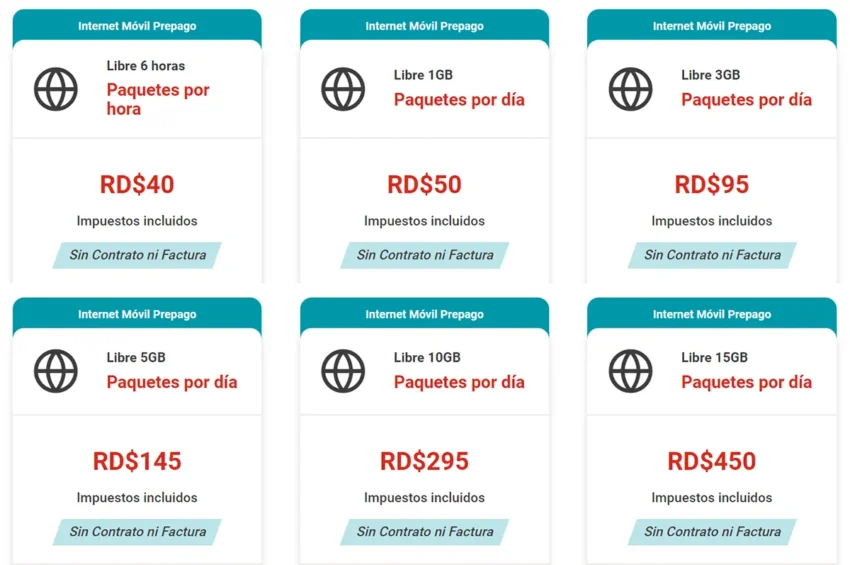
Prepaid mobile Internet plans from Claro (prices in pesos)
Source: claro.com.do
Prepaid mobile Internet plans from Altice
- 500MB/1 day: $1,74 USD
- 1GB/7 days: $5,26 USD
- 2GB/15 days: $10,54 USD
- 3GB/30 days: $14,06 USD

Prepaid mobile Internet plans from Altice (prices in pesos)
Source: altice.com.do
Claro & Altice prepaid mobile internet plans comparison
| Period | Claro | Altice |
|---|---|---|
| 1 day package | 1GB / 0,65 USD | 500MB / 1,74 USD |
| 15 days package | 15GB / 7,92 USD | 2GB / 10,54 USD |
So, depending on how long you need internet and how much data you want, you can pick the plan that suits you best. Just make sure to choose the one that matches your usage and duration, so you don’t end up paying more than you need to.
There is a little company – Wind Telecom, it has a really cheap plan of 1 day with unlimited internet for just 44 cents. They also offer 4 days of unlimited internet for $1.76.
Claro & Altice fixed internet plans comparison

Claro fixed internet plans (prices in pesos)
| Package | Speed Claro | Speed Altice | Price Claro, month | Price Altice, month |
|---|---|---|---|---|
| Up to 5Mbps | 5Mbps / 2Mbps | 5Mbps / 2Mbps | 17.33 USD | 17.40 USD |
| Up to 10Mbps | 10Mbps / 3Mbps | 15Mbps / 2Mbps | 22.13 USD | 20.89 USD |
| Up to 25Mbps | 25Mbps / 15Mbps | 30Mbps / 10Mbps | 22.56 USD | 23.68 USD |
| Up to 40Mbps | 40Mbps / 20Mbps | 50Mbps / 10Mbps | 29.53 USD | 31.34 USD |
| Up to 100Mbps | 100Mbps / 50Mbps | 100Mbps / 20Mbps | 39.98 USD | 40.05 USD |
| Up to 200Mbps | 200Mbps / 50Mbps | 200Mbps / 20Mbps | 52.18 USD | 40.05 USD (Promo) |
| Up to 300Mbps | 300Mbps / 75Mbps | 300Mbps / 20Mbps | 83.54 USD | 82.73 USD |
So, if you’re looking for a mobile internet plan, choose the one that suits your needs and budget from these options. You can always check the current fixed internet plans on the providers’ official websites here: Claro plans and Altice plans.
Is internet good in Punta Cana for tourists?
Punta Cana, the island’s easternmost tip, is renowned for its 32km stretch of beaches and clear waters. It is the perfect spot to unwind, but if you need to stay online for work or play, ensuring your internet connection is up to the task is essential.
Internet for apartment and villa renters
Renting a mid-priced villa or apartment in Punta Cana often means you’ll have a dedicated Wi-Fi connection. This is usually included in the rental price, and speeds can range from 10 to 100 Mbps. It often depends on the type of internet they’ve installed – the standard DSL or the faster fiber optic.
Always ask the landlord or rental agency about the speed and reliability of their internet connection and if there’s a limit on how much data you can use. Nowadays, with more people working remotely, many property owners offer fast internet and have fiber optic connections, so you can stream or download as much as you want.
Hotel internet in Punta Cana
Most Punta Cana hotels provide guests with complimentary Wi-Fi, although the quality can vary dramatically. While it might not be suitable for heavy online tasks, it’s typically adequate for basic communication, such as emails and social media browsing.
Luxury resorts offer faster and more reliable connections for streaming and video calls. Some fancier hotels even have special areas set up for business needs, complete with a stable wired connection so that you can work without worries.
If the internet is crucial for your stay, consider contacting the hotel beforehand to inquire about their internet speeds and whether they have business centers or dedicated areas with enhanced connections.
Punta Cana Wi-Fi – where to connect
For free, you can connect to public Wi-Fi throughout the country in restaurants, cafes, shopping centers, long-distance buses, banks, and hospitals. However, the speed and security of these connections can be inconsistent, so it’s better to avoid conducting sensitive transactions over public networks.
Internet for remote workers in
the Dominican Republic
The Dominican Republic isn’t just a vacation destination. It’s become a sought-after locale for remote workers looking for a change of scenery. However, working remotely requires more than just a stable internet connection. It necessitates a supportive infrastructure that can cater to the demands of modern digital work.
Suppose you are in the Dominican Republic as a remote worker. In that case, investing in a high-speed broadband fiber-optic cable internet connection and a local SIM card is recommended. This dual approach offers continuous online access, safeguarding against unpredictable situations like nearby construction, repair work, or power outages, which could disrupt your primary internet connection.
Possible options to connect if fixed internet disappears
Reliable internet is the backbone of remote work, but what happens when your fixed line fails? Here are several backup options:
- A solid mobile data plan can be your safety net. Consider purchasing a prepaid plan with ample data, or if you’re staying long-term, a contract plan with a local provider may offer better deals.
- Portable Wi-Fi dongles that connect to mobile networks can provide an interim solution. Similarly, pocket Wi-Fi devices offer instant access to 4G networks.
- Co-working spaces. These spaces offer robust internet connections and serve as hubs for networking with fellow digital nomads.
Essential considerations for IT professionals working in the Dominican Republic
- A laptop with a durable battery is essential due to its unpredictable power supply. Each neighborhood relies on its own power source, leading to regular power interruptions.
- Non-residents can get a local card and use Pioneer and PayPal for banking. However, only two local banks can transfer funds from PayPal to a Dominican card. To set up a local bank account, you’ll typically need identification (passport), proof of residence, and sometimes a reference letter. Some banks may also require a minimum deposit.
When it comes to electronics, purchase your tech gear before arrival in the Dominican Republic or ensure your existing equipment is in good working condition. Local prices, particularly for branded items like Apple, can be steep due to import taxes, with up to 40% markups. Most high-end products are primarily available in the capital.
- Also, finding quality repair services can be challenging if your electronics break down.
- Dominica’s coastal areas have a hot and humid climate, which can expedite corrosion. This environment can especially harm mid-range devices. Ensure you invest in high-quality equipment that can withstand these conditions for a hassle-free experience during your stay.
Before choosing an internet provider, consult your neighbors to determine which ones offer superior coverage. In some rural regions with limited cabling and Wi-Fi access, you might find local providers who can install a modem and aerial on your roof.
The cost for these services can range widely, typically starting at $10 a month and potentially going over $200. Your choice will depend on your specific needs and the available options in your location.
Tips on how to have a phone or internet service
in the Dominican Republic
- Call your phone provider. Before you buy your flight, call your phone provider. Some plans allow you to use your phone for free in countries like Argentina, Mexico, Canada, and the Dominican Republic. You might need to adjust if your plan doesn’t cover this.
- Buy a local SIM card. If your phone plan doesn’t cover international usage, you can buy a Dominican SIM card from a local store like Claro or Altis and put it in your phone.
- Don’t bring a phone, buy a new one. Another option is to leave your phone at home and buy a new phone with service in the Dominican Republic.
- Use a hotspot. You could also get a hotspot for internet service and pay monthly. You may use it if the regular internet with T-Mobile is bad or the power goes out.
Conclusions
In the Dominican Republic, the introduction of optic fiber has significantly elevated internet speeds and reliability, making it a preferred choice for many. However, mobile internet remains valuable, especially considering occasional power outages. With mobile internet, you can maintain connectivity even when electricity is switched off, ensuring continuous access and convenience in various situations.
The key takeaways for tourists
- When visiting Punta Cana, a popular tourist spot, you can expect various internet options. Many mid-priced villas and apartments offer dedicated Wi-Fi connections.
- Most hotels provide complimentary Wi-Fi, but the quality can vary. Luxury resorts typically offer faster and more reliable connections.
- Free public Wi-Fi is available in many places, but it may not always be secure or consistent.
- Consider getting a local SIM card or a pocket Wi-Fi device for reliable connectivity during your stay.
Tips for remote workers
- Remote workers should invest in a high-speed broadband landline connection and a local SIM card for backup in case of outages.
- Consider prepaid mobile data plans, portable Wi-Fi dongles, or co-working spaces as backup options for uninterrupted work.
- Ensure your tech gear is in good condition, as local prices can be high, and repair services may be limited.
Takeaways for residents
- The top internet service providers in the Dominican Republic are Claro, Altice, and Wind Telecom, offering various plans to cater to different needs.
- Fiber optic internet offers the most consistent and fastest connections and is ideal for remote work.
- Internet plans vary in price, so choose one that suits your data needs and budget.
- Consider mobile data plans as a backup in case of internet outages.
Updated on: . Author:

